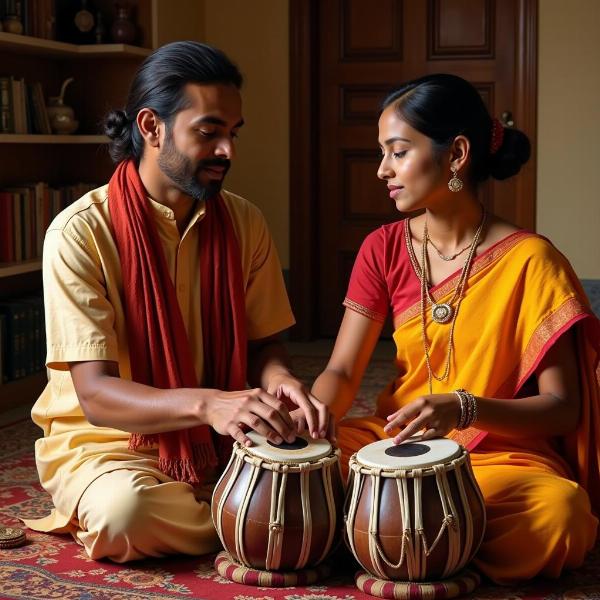Percussion instruments form an integral part of Indian music and culture. Understanding the Hindi meaning of percussion opens up a fascinating world of rhythmic intricacies and traditional significance. This article explores the various facets of percussion in the Indian context, from its linguistic roots to its cultural impact.
Exploring the Hindi Meaning of Percussion
The Hindi word for percussion is “ताल वाद्य” (taal vadya). “ताल” (taal) refers to rhythm or beat, while “वाद्य” (vadya) means instrument. Therefore, “taal vadya” literally translates to “rhythm instruments.” This term encompasses a wide range of instruments that produce sound by being struck, shaken, or scraped. From the resonant tabla to the melodious ghatam, percussion instruments add depth and vibrancy to Indian music. Think of the energetic beats accompanying a Bollywood dance number or the soulful rhythms of a classical raga; percussion plays a pivotal role.
Types of Percussion Instruments in India
India boasts a rich variety of percussion instruments, each with its unique sound and cultural significance. Some prominent examples include:
- Tabla: Perhaps the most iconic Indian percussion instrument, the tabla consists of two drums played with the hands. Its complex rhythmic patterns are a hallmark of Hindustani classical music.
- Dholak: A double-sided barrel drum, the dholak is commonly used in folk music and religious ceremonies. Its versatile sound can be both energetic and melancholic.
- Mridangam: A double-sided drum played primarily in Carnatic music, the mridangam produces a wide range of tones and textures.
- Ghatam: A clay pot played with the hands and fingers, the ghatam creates a unique resonant sound.
- Kanjira: A small frame drum with a single membrane and metal jingles, the kanjira adds a shimmering texture to South Indian music.
Cultural Significance of Percussion in India
Percussion instruments are not merely musical tools in India; they are deeply intertwined with the country’s cultural fabric. They are used in religious rituals, festivals, weddings, and other social gatherings. The rhythmic patterns of percussion instruments are believed to evoke specific emotions and create a spiritual ambiance. For example, the rhythmic cycles of the tabla are often linked to the cycles of nature and the human heartbeat.
Percussion in Different Genres of Indian Music
From classical music to Bollywood soundtracks, percussion instruments play a vital role in shaping the soundscape of Indian music. They provide the rhythmic foundation for melodies and add layers of texture and complexity. moral reason meaning in hindi In Hindustani classical music, the tabla is a central instrument, while in Carnatic music, the mridangam takes center stage. Even in contemporary Indian music, percussion instruments are used creatively to blend traditional sounds with modern influences.
Learning and Appreciating Indian Percussion
Learning to play an Indian percussion instrument can be a rewarding experience. It provides a deeper understanding of Indian music and culture. Many schools and institutions offer classes in tabla, mridangam, and other percussion instruments. unchaste meaning in hindi Even if you don’t play an instrument, simply listening to and appreciating the intricacies of Indian percussion can enrich your musical experience.
 Learning to Play Indian Percussion
Learning to Play Indian Percussion
Conclusion
The Hindi meaning of percussion, “taal vadya,” encapsulates the essence of these rhythmic instruments in Indian music. From the complex rhythmic patterns of the tabla to the resonant tones of the ghatam, percussion instruments add depth, texture, and cultural significance to a wide range of musical genres. Exploring the world of Indian percussion is a journey into the heart of India’s rich musical heritage. Understanding the “hindi meaning of percussion” allows for a greater appreciation of this vibrant tradition.
FAQ
- What is the main difference between tabla and mridangam? While both are double-sided drums, the tabla is predominantly used in Hindustani music, while the mridangam is primarily used in Carnatic music.
- Where can I learn to play Indian percussion instruments? Many music schools and cultural centers offer classes in tabla, mridangam, and other percussion instruments.
- What is the significance of percussion in Indian culture? Percussion instruments are deeply intertwined with Indian culture and are used in religious ceremonies, festivals, and other social gatherings.
- Are percussion instruments only used in traditional Indian music? No, percussion instruments are also used in contemporary Indian music, often blending traditional sounds with modern influences. recant meaning in hindi
- What is the literal translation of “taal vadya”? “Taal vadya” literally translates to “rhythm instruments.”unplugged songs meaning in hindi
- Is it difficult to learn Indian percussion? Like any musical instrument, learning Indian percussion requires dedication and practice, but it can be a rewarding experience.
- What are some other examples of Indian percussion instruments? Besides tabla and mridangam, other examples include dholak, ghatam, kanjira, and pakhawaj. hindi meaning of trumpet
Meaning-Hindi.in is your one-stop solution for all your Hindi translation needs. We specialize in a wide range of translation services, including business and commercial document translation, certified and legal document translation, technical and user manual translation, website and localization translation, educational and academic document translation, and fast and urgent translation services. Our expert linguists ensure accurate and culturally sensitive translations for diverse industries. Contact us today for all your Hindi translation requirements at [email protected] or +91 11-4502-7584. Meaning-Hindi.in is committed to delivering high-quality, professional translation services that bridge language barriers and connect cultures.